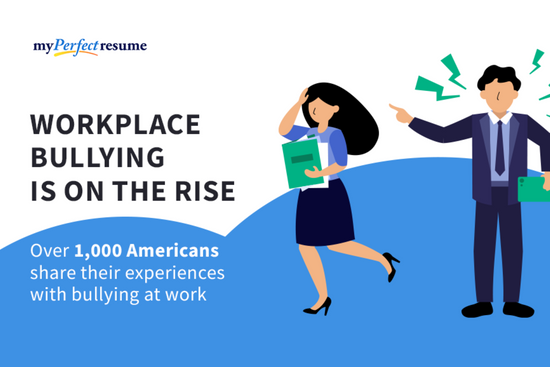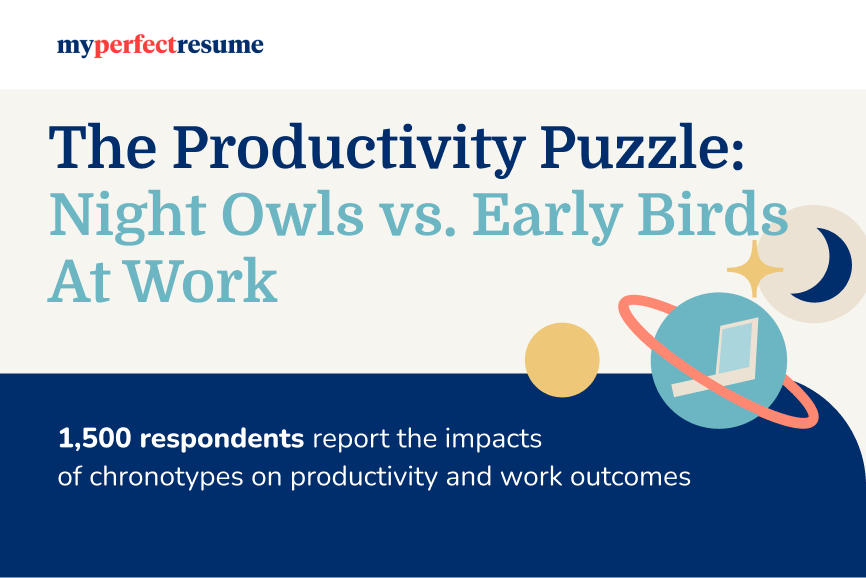The Escalating Issue of Workplace Bullying: A 2021 Analysis
MyPerfectResume.com [March 06, 2023],
[https://www.myperfectresume.com/career-center/careers/basics/workplace-bullying-in-2021]

Our customers have been hired at: *Foot Note
Nothing is certain in this world except death, taxes, and that you’ll have to deal with a bully at some point in your career. If you’ve already met one, you know firsthand it can be a soul-crushing experience straight from Dante’s Inferno. It makes you count down the days until the week’s end. And it muscles your stomach to do a 360 when Monday arrives.
That's why at MyPerfectResume, we've decided to explore the state of workplace bullying in 2021. We asked 1,000+ Americans if they’ve ever witnessed or personally experienced bullying and what adverse effects it can have on employers and employees alike.
The State of Bullying at Work in 2021
Prevalence of bullying
As mentioned earlier, bullying doesn’t just happen on the school playground. In fact, this spiteful, offensive, and intimidating behavior remains common in workplaces.
How common, exactly?
According to our findings, a full 79% of working professionals have indirectly experienced or witnessed bullying at work (78% of women vs. 80% of men.) Another 66% of employees have personally become victims of workplace bullying (69% of women vs. 63% of men). While that number might seem high, it goes hand-in-hand with similar studies on the topic.
Interestingly, the majority of bullies aren’t bosses who you think would be the typical suspects. In over 50% of cases, bullying comes from coworkers, according to our survey:
- Coworkers - 52%
- Direct managers - 33%
- External managers - 8%
- Other company employees - 6%
One of the respondents elaborates on their past bullying experience with a coworker:
A coworker would continually degrade and embarrass another coworker. It'd mostly be simple things like making fun of eating a microwave lunch instead of takeout, what she wore, etc. The bully felt as if she competed with the person she was bullying.
Upon closer examination of the data, we also uncovered that younger employees who don't have much experience under their belt are more often bullied by coworkers than veteran employees. Here’s how the amount of bullying that comes from peers and coworkers declines with more work experience:
- 1–2 years - 61%
- 3–5 years - 54%
- 6–10 years - 52%
- 11–20 years - 49%
Types of bullying
Bullying can rain down from nearly any place within an organization. It can also take different forms.
Here are the most common types of workplace bullying, according to our respondents:
- Being picked on or getting regularly undermined - 60%
- Becoming a victim of malicious rumors - 30%
- Having someone interfere with your work - 29%
- Receiving aggressive texts, emails, or phone calls - 23%
- Getting your work sabotaged - 12%
To give you a better idea of what “getting picked on” could mean, below is a horrifying account of one of the survey takers:
At my previous job, my boss told me my performance was the worst he'd ever seen and that what I was doing had no value to the company. I worked 60+ hours every week, and yet my boss belittled every task I did. He also made fun of my weight, calling me fat and poking fun at how much I sweat when I'm nervous. Once, my boss called me a p***y to my face when I asked for some time off to be with my mom during surgery. The job completely wiped out all of my confidence.
In this context, we found that female employees are more picked on and undermined than men (66% vs. 55%). Perhaps, that’s because some women find it harder to stand their ground against a bully, lacking men’s self-assuredness.
We’ve also discovered that rookies that have been in the workforce for only 1–2 years are more likely to have someone interfere with their work than more veteran employees with 3–5 years of experience (38% vs. 24%).
Lastly, American workers with a Bachelor's or Associate's degree more often become victims of malicious rumors than blue-collar employees with only a high-school diploma, according to our findings (31% vs. 24%).
Does bullying get reported?
At this point, we wanted to ask Americans if they report this health-harming mistreatment.
It turns out—49% of employees don’t report workplace bullying and prefer to keep it under wraps. The remaining 51% of workers report getting bullied to:
- Their own boss - 24%
- Senior manager - 20%
- HR - 16%
- Attorney - 1%
Interestingly, more experienced employees that have been in the workforce for 6–10 years are more willing to come forward and report bullying than their younger colleagues with only 1–2 years of professional experience (59% vs. 46%).
Similarly, working professionals with some college experience (but without a degree) prefer to keep things a secret from others, unlike those with a Bachelor’s or Associate's degree (37% vs. 52%)
Do workplace bullies get away?
Not everyone gives bullies a pass.
Based on our findings, 51% of employees who stand their ground against a bully say the following action was taken after they filed a complaint:
- The bully was reprimanded in some way - 48%
- The bully was fired - 28%
- Nothing changed - 25%
That’s good news.
It shows employees’ complaints don’t fall on deaf ears, for the most part (although we couldn’t confirm or refute the above statistics due to a lack of available data on the topic and survey limitations.)
But it’s not all sunshine and roses.
When we examined the data more closely, we found that the more experience the target had, the more there was no action taken against their bully. The below percentages show how inaction arguably increases with seniority:
- 3–5 years - 13%
- 6–10 years - 11%
- 11–20 years - 22%
- 20+ years - 44%
Perhaps, it indicates that top-performing employees high in the org chart are often valued and supported by their employers to the point where they grow immune to mere mortals’ complaints.
Adverse Effects of Workplace Bullying
Most companies are aware of the detrimental effects of bullying. It creates a toxic environment and results in employee disengagement, absenteeism, and, most importantly, higher turnover rates.
In fact, according to our findings, a full 47% of employees have quit their job because of bullying. That made their companies start the costly recruitment, hiring, and onboarding dance all over again. If you are considering a switch to a new job, check out our comprehensive guide on how to write a letter of resignation for a job.
Interestingly, old-timers (with 20+ years of professional experience) are less likely to throw in the towel than their younger counterparts (with 3–5 years of experience): 64% vs. 48%, respectively.
But—before pulling the trigger, here’s how long US workers put up with a bully:
- One year or less - 44%
- Two - 28%
- Three - 15%
- Five or more - 9%
- Four - 4%
That means nearly half of Americans will quit their job within one year or less if faced with a bully. That number is in line with Monster’s data, and it’s even higher (56% vs. the original 44%) for people with low-income jobs (less than $24,999/year).
It makes sense given the detrimental effects bullying can have on employees. They include,
- High-stress levels - 46%
- Deteriorated performance - 25%
- Inability to concentrate -21%
- Sleep loss - 21%
- Incapacity to make decisions - 20%
It's also noteworthy that women experience higher stress levels than men (52% vs. 40%) and suffer more from sleep loss (26% vs. 15%) when bullied.
Lastly, we asked the respondents if switching to telecommuting affected the amount of bullying at their companies. Below are the results:
- Things have improved - 54%
- No difference - 32%
- Things have deteriorated - 14%
As expected, remote work has lowered the amount of bullying in the workplace, as stated by 54% of employees. After all, having the benefit of not sharing a physical space with a bully is hard to underestimate.
But, WFH doesn’t always solve the problem, especially since most companies still plan to return onsite eventually. One of the respondents explains,
Because we no longer work from the office, our manager started to send aggressive text messages at all times of the day. It could be 4:00 in the morning or 11:00 at night, and he'll be lashing out about business. Worse, he also enjoys embarrassing a group member in front of others in our team chat on Slack.
Stacking It All Up
One of the reasons bullying doesn't get reported is that bullies are often high-functioning employees who bring top-dollar to the company. They could be a top salesperson who can quadruple the company's profits or an IT professional that can do the job of four while juggling several side projects. As a result, it might give the target a sense the company will do anything to keep such toxic workers around and happy, making their complaints futile. Another roadblock is employees' fear of harmful job and career consequences.
Regardless of the reason, it’s critical to take bullying head-on.
If you’re an employee:
- Address the bully’s behavior in the first instance in an informal setting.
- If that doesn’t work, document specific details of the bully’s misconduct and seek help from your manager (unless he’s the bully, of course), HR, or someone in power.
- Insist the company carries out a meaningful investigation and takes appropriate action.
If you’re a leader:
- Roll out a policy that outlines bullying behaviors, what forms it can take, and the repercussions for breaching it.
- Foster a transparency-rich environment where employees are willing to be raw and voice their issues and concerns.
If you turn your head the other way or otherwise try to cover up bullying, it can dent your bottom line, lower company-wide performance, and generally create a toxic culture that drives away talent.
Methodology
We surveyed 1,024 respondents online via a bespoke polling tool on their experiences with workplace bullying. All respondents included in the study passed an attention-check question. The study was created through several steps of research, crowdsourcing, and surveying.
Limitations
The data we are presenting rely on self-reports from respondents. Each person who took our survey read and responded to each question without any research administration or interference. There are many potential issues with self-reported data like selective memory, telescoping, attribution, or exaggeration.
Some questions and responses have been rephrased or condensed for clarity and ease of understanding for readers. In some cases, the percentages presented may not add up to 100 percent; depending on the case, this is either due to rounding or due to responses of "neither/uncertain/unknown" not being presented.
Fair Use Statement
Don't miss the chance to share these findings–you might regret it! If you think your audience will be interested in this information, you can share it for noncommercial reuse. All we ask in return is that you link back to this page so that your readers can view the full study.
About Us
At MyPerfectResume, we stand against workplace bullying and believe in creating a safe and inclusive environment for all professionals. Our extensive range of great resume examples (written by certified professional resume writers) and professional resume templates empower individuals to showcase their skills and experiences, helping them secure opportunities in healthy work environments. Explore our resources and use our resume maker create a compelling resume that highlights your strengths, enabling you to take control of your career and overcome workplace adversity.
How we reviewed this article
Since 2012, we have helped more than 11 million job seekers. We want to make your career journey accessible and manageable through our services and Career Center’s how-to guides and tips. In our commitment to bring you a transparent process, we present our Editorial Process.
Sources
- https://www.workplaceviolence911.com/docs/20081215.pdf
- https://www.monster.com/career-advice/article/workplace-bullying-what-can-you-do
- https://www.psychologytoday.com/us/blog/the-right-mindset/202001/bullying-against-adults-has-risen
- https://resumelab.com/career-advice/confidence-at-work at-can-you-do
- https://www.ncbi.nlm.nih.gov/pmc/articles/PMC4382139/
- https://maxmyprofit.com.au/effects-of-workplace-bullying-on-your-business/
- https://www.workplaceviolence911.com/docs/20081215.pdf
Our customers have been hired at:*Foot Note









